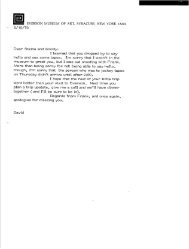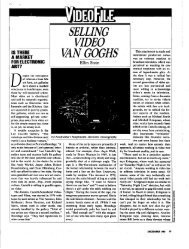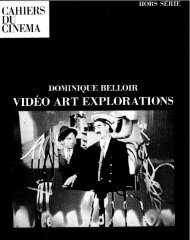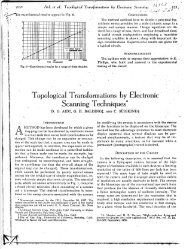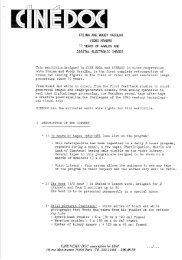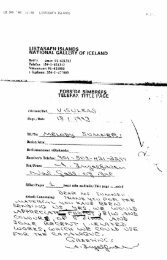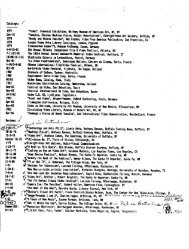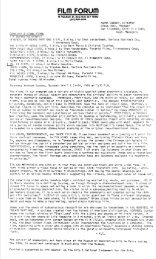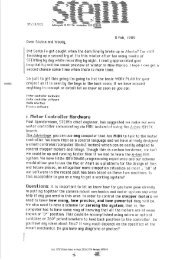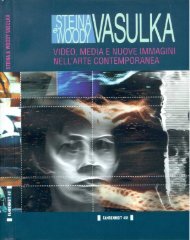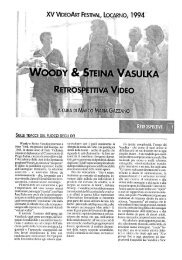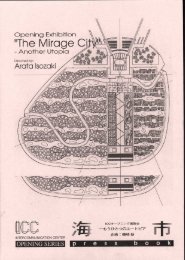MEDIA STUDY/BUFFALO - the Vasulkas
MEDIA STUDY/BUFFALO - the Vasulkas
MEDIA STUDY/BUFFALO - the Vasulkas
You also want an ePaper? Increase the reach of your titles
YUMPU automatically turns print PDFs into web optimized ePapers that Google loves.
Robert Smithson's Spiral Jetty. Photo : Castelli-Sonnabend Tapes and Films, Inc.<br />
February 24 (Friday)<br />
8:30 PM<br />
Albright-Knox Art Gallery<br />
SPIRAL JETTY (1970)<br />
By Robert Smithson . Color . 35<br />
minutes .<br />
Spiral Jetty was constructed in 1970 in<br />
<strong>the</strong> shallow waters on <strong>the</strong> north-east<br />
shore of <strong>the</strong> Great Salt Lake, Utah . The<br />
coil of <strong>the</strong> jetty extends approximately<br />
1,500 feet in length, is about 15 feet<br />
wide and composed of black basalt<br />
rock, salt crystals, earth, red water and<br />
sunlight reflections . About 6,650 tons<br />
of earth and boulders were used in its<br />
construction . The film revolves around<br />
<strong>the</strong> making of this earth sculpture, but<br />
Smithson saw it as a cinematic project,<br />
interweaving <strong>the</strong> associations evoked<br />
by <strong>the</strong> spiral and geological time, ra<strong>the</strong>r<br />
than as a~straightforward documentary .<br />
PAUL REVERE (1971)<br />
By Joan_ .Jonas and Richard Serra .<br />
Black and White . 9 minutes.<br />
According to its makers, Paul Revere "is<br />
an adaptation of two sources : Kinesics<br />
and Context, by Ray L . Birdwhistle, and<br />
Choreomania, a performance by Joan<br />
Jonas ." A didactic work inspired by <strong>the</strong><br />
structure of <strong>the</strong> educational film using<br />
instructional cards, Paul Revere deals<br />
with <strong>the</strong> nature and limits of communications<br />
systems . The initial model<br />
is Paul Revere's signalling light tower<br />
to alert <strong>the</strong> town of <strong>the</strong> coming of <strong>the</strong><br />
British, and <strong>the</strong> film proceeds to<br />
demonstrate <strong>the</strong> inadequacies of this<br />
system and <strong>the</strong> necessity of<br />
establishing ano<strong>the</strong>r system to serve as<br />
a check for it . The secondary system<br />
itself generates fur<strong>the</strong>r contingencies<br />
and possible ambiguities of interpretation<br />
and <strong>the</strong>reby necessitates a third -<br />
ultimately unsatisfactory - signalling<br />
system .<br />
MIRACLE (1975)<br />
By Ed Ruscha . With Jim Ganzer,<br />
Michelle Phillips, and Dana Derfus. Color.<br />
30 minutes.<br />
Ed Ruscha's film, Miracle, is a narrative<br />
about an auto mechanic confronted<br />
with <strong>the</strong> challenge of fixing a '65<br />
Mustang with a fuel problem . The setting<br />
is pure L .A . and <strong>the</strong> mechanic's<br />
character a pure stereotype : he has<br />
photos of pin-up girls on <strong>the</strong> garage<br />
walls, eats tuna-fish sandwiches on<br />
Wonder Bread, and has a sexist but<br />
coy attitude toward <strong>the</strong> women he<br />
stands up in order to fix <strong>the</strong> car (including<br />
Michelle Phillips as <strong>the</strong><br />
petulant, Doublemint-chewing Trixie) .<br />
March 9 (Friday)<br />
8:30 PM<br />
Albright-Knox Art Gallery<br />
VINYL (1965)<br />
ByAndy Warhol. With GerardMalanga,<br />
Edie Sedgwick, Bob "Ondine" Olivo,<br />
and Tosh Carillo. Black and White. 70<br />
minutes.<br />
Vinyl stars poet and Warhol-superstar<br />
Gerard Malanga as a young, juvenile<br />
delinquent punk who "keeps lighting<br />
cigarettes menacingly until he<br />
becomes <strong>the</strong> victim of some obscure<br />
and ludicrous torture arrangement,<br />
which, correctly, is all preparation ." (Art<br />
News) According, to Ronald Tavel,<br />
author of <strong>the</strong> scenario- for Vinyl,<br />
"Gerard Malanga offers us a performance<br />
that is unique in cinema history.<br />
Startling , and distressing,<br />
Malanga's performance will mystify <strong>the</strong><br />
uninitiated and upset <strong>the</strong> thoughtful ."<br />
Vial also marked Edie~Gedgwick's first<br />
film appearance, and it proved to be<br />
one of Warhol's most popular early narrative<br />
works .<br />
MIRROR (1969)<br />
by Robert Morris . Black and White .<br />
Silent . 9 minutes .<br />
Morris walks in a complete circle<br />
across a landscape, holding up to <strong>the</strong><br />
camera a large mirror which reflects<br />
<strong>the</strong> surrounding trees, snow and sky.<br />
Image from John Baldessari's Title. Photo : Castelli-Sonnabend Tapes and Films, Inc.<br />
From Paul Revere, by Joan Jonas and Richard Serra.<br />
Photo : Castelli-Sonnabend Tapes and Films, Inc .<br />
There is<br />
FUSES (1964-67)<br />
a close-up of <strong>the</strong> cameraman<br />
which can soon be identified as a<br />
By Carolee Schneemann. Color. Silent. reflected image . Eventually <strong>the</strong> camera<br />
23 minutes.<br />
is no longer seen in reflection ; instead<br />
Described by film critic Gene <strong>the</strong> mirror creates a 180 0 shift of view<br />
Youngblood as "very Joycean and very as <strong>the</strong> camera directly records Morris<br />
erotic," Carolee Schneemann's Fuses is walking fur<strong>the</strong>r and fur<strong>the</strong>r into <strong>the</strong><br />
a record of her sexual experiences background . At this point <strong>the</strong> mirror is<br />
made over a three-year period using a not acting as a reflector and functions<br />
simple hand-wind camera, natural merely to bounce light and not images .<br />
light, and a cooperative partner. Complexly<br />
edited and organized, APPLICATIONS (1970)<br />
Scheemann composed <strong>the</strong> work according<br />
to a "fugal structure" which en-<br />
By Vito Acconci .<br />
20 minutes .<br />
Super-8. Color. Silent .<br />
compassed "gesture, color sequences, Applications is <strong>the</strong> film of a live perfor-<br />
collage, montage, superimposition, mance done at <strong>the</strong> Art Institute of<br />
painting frame-by-frame, breaking <strong>the</strong> Chicago . Kathy 1D11on'puts on heavy<br />
frame ."<br />
red lipstick and kisses <strong>the</strong> upper part<br />
of Acconci's body - neck, shoulders,<br />
I a,<br />
MA ch 1'5 (Thursday)<br />
chest, arms, and stomach - until it is<br />
covered with <strong>the</strong> imprints of her mouth .<br />
Acconci <strong>the</strong>n rubs <strong>the</strong> front of his body<br />
8:3~ PM<br />
against Dennis Oppenheim's back,<br />
Albright-Knox Art Gallery<br />
removing all traces of color from<br />
himself and transferring <strong>the</strong>m to<br />
Oppenheirn .<br />
TITLE (1971)<br />
By John Baldessari . Black & White and<br />
Color. 18 minutes .<br />
Title exploits <strong>the</strong> conventions of narrative<br />
plot development in a series of<br />
images, or "Episodes," that feed into<br />
succeeding episodes, often inexplicably.<br />
Episode 1 introduces <strong>the</strong><br />
"protagonists" : a rock, a chair, a dog,<br />
a young man, a landscape. subsequent<br />
episodes present various pairings<br />
of <strong>the</strong>se elements, simple movement<br />
events, imageless aural activities,<br />
elliptical passages of a possible<br />
melodrama, still lifes of fruits and<br />
vegetables, views of L.A ., and so forth .<br />
The film ends with an "Epilogue" portraying<br />
two cloyingly romantic views of<br />
<strong>the</strong> beach .<br />
RAILROAD TURNBRIDGE<br />
(1976)<br />
By Richard Serra . Black and White .<br />
Silent . 19 minutes .<br />
Begun in 1975, Richard Serra's<br />
Railroad Turnbridge is a film portrait<br />
shot by <strong>the</strong> artist of an old drawspan<br />
turnbridge that crosses <strong>the</strong> Williamette<br />
River in Portland, Oregon . According<br />
to Serra, "I wanted to look through <strong>the</strong><br />
camera closely at something I like and<br />
understand : steel structure . The bridge<br />
and <strong>the</strong> film became mutually interdependent<br />
: <strong>the</strong> bridge enabled me<br />
to examine movement in filmic structure<br />
; <strong>the</strong> filming berame a way of<br />
isolating and concentrating certain<br />
iconic elements of bridge structure."<br />
3 1



